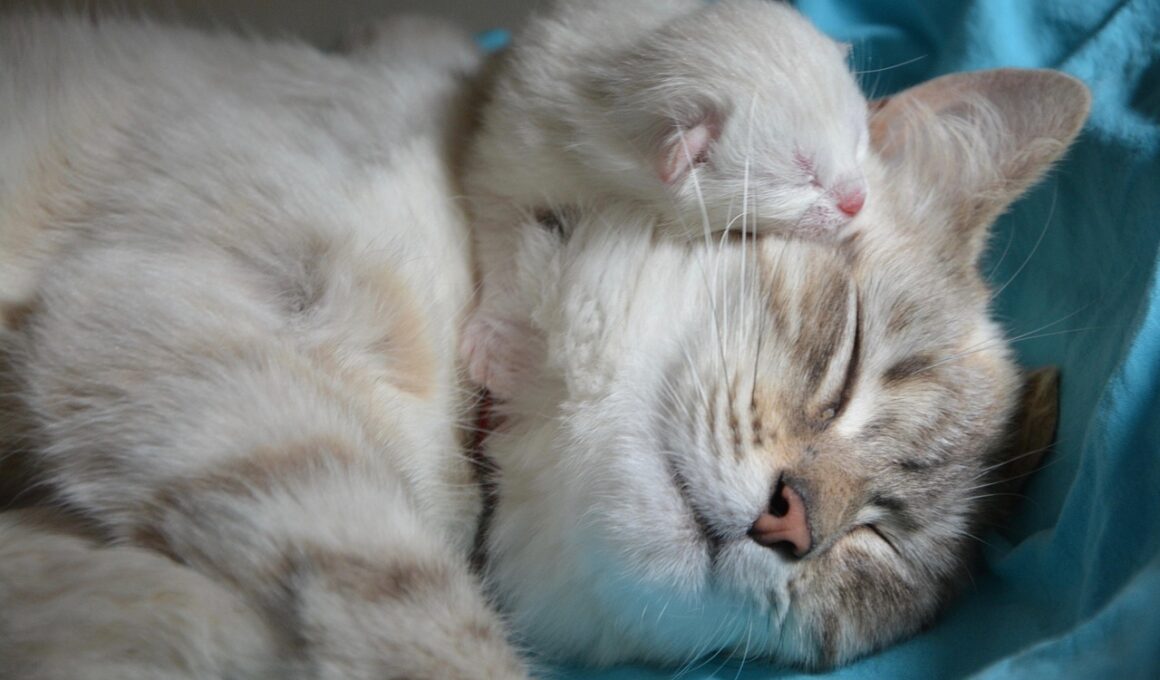Best Practices for Weaning Kittens While Ensuring Maternal Nutrition
Weaning kittens is a crucial phase that requires attention to both maternal and kitten nutrition. Creating a gradual weaning process ensures that the kittens transition smoothly from their mother’s milk to solid food. This period typically starts when kittens are around four weeks old but can vary. The initial introduction to solid food should be a soft, wet diet to aid digestion. Gradually mix quality kitten food into the feline diet; this includes nutrient-rich proteins, fats, and necessary vitamins to foster healthy growth. Monitor the kittens closely for any signs of digestive problems, such as diarrhea. If issues arise, consult with a veterinarian for tailored advice. It is essential that the mother cat continues to receive adequate nutrition during this time. Providing her with high-quality, calorie-dense food helps maintain her health while nursing and supports her energy needs. The transition should last several weeks, allowing both kittens and the mother to adjust to changing feeding patterns. Return the kittens to their mother for nursing sessions to ensure they receive the antibodies necessary for healthy development, while also supporting maternal well-being.
The diet of the mother cat during this period cannot be overlooked. Maintaining her strength and milk production is vital for the kittens’ health. Focus on a balanced diet that includes crucial nutrients such as proteins, fats, vitamins, and minerals. Ideal food choices may include high-quality kitten food, as it typically contains higher fat content, catering to nursing mothers. Additionally, consider supplementing her diet with wet and dry food to encourage optimal hydration. It’s crucial to avoid sudden dietary changes, as they can lead to gastrointestinal distress. Introduce new foods gradually to prevent potential reactions. The environment also plays a significant role during the weaning process. Ensure that the weaning space is comfortable, warm, and free from stressors. Both mother and kittens benefit from a calm environment to ease the transition. To foster socialization, engage the kittens with toys and gentle handling. This interaction not only stimulates their development but also strengthens their bonds with the mother. Regular veterinary check-ups throughout this process are advisable to ensure that both the mother and kittens remain healthy and to address any concerns efficiently.
Understanding Nutritional Requirements
To ensure successful weaning, it’s essential to understand the nutritional requirements of the mother cat and her kittens. As the kittens grow, their dietary needs evolve, and so does that of the mother. Kittens, particularly in the weaning stage, require a diet rich in proteins and fats to support their rapid growth rates. Foods specifically formulated for kittens often contain targeted levels of taurine, DHA, and other necessary components for brain and eye development. For the mother cat, high-energy foods are necessary to replenish the nutrients lost during lactation. Ensure she has unrestricted access to fresh water at all times, as hydration is crucial for optimal milk production. As nursing diminishes, add more solid foods to your kittens’ diet, gradually reducing milk intake. Pay attention to their growth patterns; kittens should gain weight steadily throughout their weaning phase. Consult your veterinarian on an appropriate feeding schedule, ensuring both mother and kittens receive the right balance of nutrition. Keeping detailed observations on each kitten’s growth trajectory can establish the effectiveness of your feeding strategy and prompt adjustments as needed.
Being conscious about portion sizes during the transition is equally important. Overfeeding can lead to obesity or digestive issues in both the mother and kittens, while underfeeding may inhibit healthy growth. Monitor your kittens’ body weight regularly and adjust feeding amounts accordingly. Typically, this can involve feeding smaller portions more frequently, which mimics their natural nursing behavior. Incorporating a mix of wet and dry foods can help balance calorie intake while satisfying their preferences. Additionally, consider offering different flavors or types of food to help the kittens develop their tastes. This can set the stage for life-long healthy eating habits. Furthermore, it’s important to avoid feeding them human food or treats high in sugars and fats while adjusting their diets. For any concerns regarding specific food types or ingredients, consulting with a vet is key. They can provide insights on safe options and what to avoid, especially while transitioning from maternal milk to solid foods. Engaging in regular training and socialization during meals can also enhance their learning experience and improve their behavior in future feeding scenarios.
Nurturing Social Development
Weaning is not only about nutrition but also allows for crucial social interaction among kittens and their mother. During this phase, engage the kittens in play and socialization to help them learn important social skills that will serve them throughout their lives. Interaction with littermates is essential, as they learn how to communicate and establish appropriate boundaries. Introduce toys that encourage active play, enhancing both physical and cognitive skills. Offering a balance of different types of playtime will also help reduce stress and promote mental health. Observe the kittens for signs of stress, such as excessive vocalization or aggression, and provide a separate space if needed. The mother cat plays an integral role in teaching behavioral cues and social norms. Allow her to guide the kittens in their interactions, ensuring they understand proper cat behaviors. They should learn to engage in normal feline play, like stalking and pouncing, which nurtures their innate hunting instincts. Gradually allowing the kittens to interact with humans is also crucial, promoting positive social behaviors that will serve them well in their adult life.
While weaning can be a complex process, clear communication and patience are key components to success. As progress is made, avoid rushing the process; each kitten has its own pace when adapting to life without nursing. Encouragement and support from caregivers can help build their confidence as they explore new foods and social interactions. The early weaning period can be a time of adjustment for both mother and kittens, filled with challenges that require understanding and compassion. It’s essential to remain observant of any behavioral changes—some kittens may cling to their mother’s milk longer than others. Establish a routine that incorporates consistent feeding times, play, and social interaction to foster stability during this transition. Following their cues and gradual responses helps make the process more comfortable and effective. Consult with veterinarians to develop feeding and care plans that reflect individual needs during weaning. As the kittens develop, introduce new environments and experiences to expose them to diverse sights and sounds, which prepares them for their journey into adulthood.
Continuous Monitoring and Adaptation
Weaning kittens successfully requires ongoing monitoring of both their nutrition and behaviors throughout this transition. Stay attuned to how both mother and kittens respond to dietary changes and social interactions; this can almost dictate the overall progress of the weaning process. Adjustments may be necessary based on specific needs observed during this time. For example, if kittens display reluctance to eat solid foods, revert to softer textures and gradually increase the variety offered. The health of the mother cat is paramount; if she shows signs of stress or health decline, consult a veterinarian promptly to determine the underlying causes. Keeping a record of their growth and dietary intake will also provide insights into what works and what doesn’t during this journey. Education on recognizing the signs of successful weaning and general well-being will serve caregivers well, ensuring an enjoyable experience for both mother and her kittens. Once kittens have successfully transitioned to solid food and gained independence, finding loving homes should be the next focus. Encourage prospective owners to understand optimal nutrition and care underscoring early kitten training and health.
The journey of weaning is a significant milestone not just for kittens but also for their mothers. Taking care of both their nutritional requirements and behavioral development throughout this phase will lay the foundation for their future health and well-being. With proper management, support, and the right approaches, caregivers can feel confident in transitioning kittens from a milk-dependent diet to independent eating. Engaging support networks, whether they include veterinarians, cat nutritionists, or experienced cat owners, can also assist in providing vital insights. Utilizing resources available, including reputable books and online forums, can supplement know-how in this domain. By approaching the matter with compassion and understanding, caregivers can create an enriching environment that benefits both mother and kittens alike. The bond formed during this period will influence the kittens’ behavior throughout their lives. Encourage potential little owners to understand this critical early development stage, as it’s essential to nurturing well-adjusted adult cats. Ultimately, responsible weaning practices will contribute to healthier pets, portraying how vital the early stages of life are in ensuring confidence and stability for kitten development.


